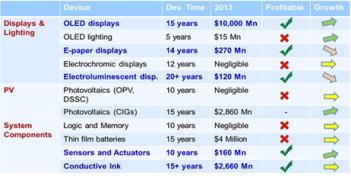The new report from IDTechEx titled "Printed, Organic & Flexible Electronics: Forecasts, Players & Opportunities 2013-2023" finds that the total market for these technologies will grow from $16.04 billion in 2013 to $76.79 billion in 2023.
The sector includes profitable large sectors, the majority being OLEDs (organic but not printed) and conductive ink used for a wide range of applications. On the other hand, stretchable electronics, logic and memory, thin film sensors and other components are much smaller segments today, just emerging from R&D. A snapshot view of the technologies, development time, 2013 market size and general sector profitability and short term growth is shown below.
Billion-dollar sale successes
So far there have been three billion-dollar sales successes; OLEDs, e-paper and conductive ink. OLEDs are seeing continual adoption in cellphones and OLED TV sales have begun this year. IDTechEx see much movement in the display sector, as panel makers try and distance themselves from losses in the LCD industry, caused by new competition from China, and seek to differentiate. The landscape will change - with some East Asian countries potentially unable to afford extensive R&D in OLEDs such as Taiwan and new entrants, such as China. E-paper sales have declined as e-reader sales have declined. To reach that sales peak again new markets are being explored as is colour, video capable bistable displays. IDTechEx find that the overall conductive ink market size is in decline this year as it was last year, due to less use in the photovoltaic market. However, thereafter the market will increase again as the PV sector shakes-out and other markets for conductive inks continue to grow.
 Table 1. State of commercialization of printed, organic and flexible electronics in 2013. Source: IDTechEx report "Printed, Organic & Flexible Electronics: Forecasts, Players & Opportunities 2013-2023" (www.IDTechEx.com/pe). Note that in some cases above the value of the film is included and not the module value - see the report for more detail.
Table 1. State of commercialization of printed, organic and flexible electronics in 2013. Source: IDTechEx report "Printed, Organic & Flexible Electronics: Forecasts, Players & Opportunities 2013-2023" (www.IDTechEx.com/pe). Note that in some cases above the value of the film is included and not the module value - see the report for more detail.
Companies reposition for profitability
Some companies have survived ten years without making substantial sales or any profit. Some of these are now repositioning from trying to do something very difficult, such as replacing complete existing devices, to simpler things, allowing them to move to market more quickly. Few can keep going after ten years of minimal sales. Examples of new focus include finely printed patterns for transparent conductive films (a $1.8 billion opportunity), improving the performance of lithium batteries (a $25 billion market), enabling supercapacitors for vehicles and consumer electronics ($0.8 billion in 2013) and adding 3D touch surfaces to many things, as Ford has done for its overhead consoles in some cars.
Some systems development but much more to be done
A few vendors are building ecosystems to develop complete systems - bringing together key enabling components and creating complete working devices. Watch Thinfilm, PARC, PST, PragmatIC and Soligie amongst others. For equipment manufacture it is notable that NovaCentrix and Muhlbauer have come together to provide a turnkey solution for RFID tag manufacture using copper ink for the tag antennas - now the purchaser does not have to try and build the disparate systems themselves. Still, there is quite a way to go. For example, even simply creating hybrid devices - part printed, part conventional on the same substrate is proving a challenge to automate.
Broadening topic
The topic is broader than many people realize. There is strong interest in printed electronics enabling part of the Internet of Things vision; researchers are working on bringing together 3D printing with electronics; bioelectronics; touch surfaces everywhere and much more.
New research report from IDTechEx
The IDTechEx report "Printed, Organic & Flexible Electronics: Forecasts, Players & Opportunities 2013-2023" (www.IDTechEx.com/pe) provides detailed analysis of all these aspects, including ten year forecasts. If you are looking to understand the big picture, the opportunity, the problems you can address, or how you can start to use these technologies and the implications involved, this report is a must. Researched by multilingual IDTechEx consultants based in four countries and three continents, this report builds on ten years of knowledge of the industry.
About IDTechEx
IDTechEx guides your strategic business decisions through its Research and Events services, helping you profit from emerging technologies. We provide independent research, business intelligence and advice to companies across the value chain based on our core research activities and methodologies providing data sought by business leaders, strategists and emerging technology scouts to aid their business decisions.